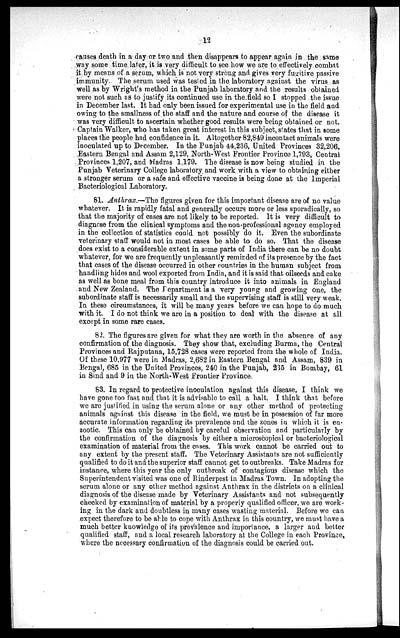Medicine - Veterinary > Civil Veterinary Departments > Annual administration report of the Civil Veterinary Department of India > 1907-1908 > Part A - Provincial administration
(23) Page 12
Download files
Individual page:
Thumbnail gallery: Grid view | List view

12
causes death in a day or two and then disappears to appear again in the same
way some time later, it is very difficult to see how we are to effectively combat
it by means of a serum, which is not very strong and gives very fugitive passive
immunity. The serum used was tested in the laboratory against the virus as
well as by Wright's method in the Punjab laboratory and the results obtained
were not such as to justify its continued use in the field so I stopped the issue
in December last. It had only been issued for experimental use in the field and
owing to the smallness of the staff and the nature and course of the disease it
was very difficult to ascertain whether good results were being obtained or not.
Captain Walker, who has taken great interest in this subject, states that in some
places the people had confidence in it. Altogether 82,849 incontact animals were
inoculated up to December. In the Punjab 44,236, United Provinces 32,206,
Eastern Bengal and Assam 2,129, North-West Frontier Province 1,793, Central
Provinces 1,207, and Madras 1,179. The disease is now being studied in the
Punjab Veterinary College laboratory and work with a view to obtaining either
a stronger serum or a safe and effective vaccine is being done at the Imperial
Bacteriological Laboratory.
81. Anthrax.—The figures given for this important disease are of no value
whatever. It is rapidly fatal and generally occurs more or less sporadically, so
that the majority of cases are not likely to be reported. It is very difficult to
diagnose from the clinical symptoms and the non-professional agency employed
in the collection of statistics could not possibly do it. Even the subordinate
veterinary staff would not in most cases be able to do so. That the disease
does exist to a considerable extent in some parts of India there can be no doubt
whatever, for we are frequently unpleasantly reminded of its presence by the fact
that cases of the disease occurred in other countries in the human subject from
handling hides and wool exported from India, and it is said that oilseeds and cake
as well as bone meal from this country introduce it into animals in England
and New Zealand. The Department is a very young and growing one, the
subordinate staff is necessarily small and the supervising staff is still very weak.
In these circumstances, it will be many years before we can hope to do much
with it. I do not think we are in a position to deal with the disease at all
except in some rare cases.
82. The figures are given for what they are worth in the absence of any
confirmation of the diagnosis. They show that, excluding Burma, the Central
Provinces and Rajputana, 15,728 cases were reported from the whole of India.
Of these 10,977 were in Madras, 2,682 in Eastern Bengal and Assam, 839 in
Bengal, 685 in the United Provinces, 240 in the Punjab, 235 in Bombay, 61
in Sind and 9 in the North-West Frontier Province
83. In regard to protective inoculation against this disease, I think we
have gone too fast and that it is advisable to call a halt. I think that before
we are justified in using the serum alone or any other method of protecting
animals against this disease in the field, we must be in possession of far more
accurate information regarding its prevalence and the zones in which it is en-
zootic. This can only be obtained by careful observation and particularly by
the confirmation of the diagnosis by either a microscopical or bacteriological
examination of material from the cases. This work cannot be carried out to
any extent by the present staff. The Veterinary Assistants are not sufficiently
qualified to do it and the superior staff cannot get to outbreaks. Take Madras for
instance, where this year the only outbreak of contagious disease which the
Superintendent visited was one of Rinderpest in Madras Town. In adopting the
serum alone or any other method against Anthrax in the districts on a clinical
diagnosis of the disease made by Veterinary Assistants and not subsequently
checked by examination of material by a properly qualified officer, we are work-
ing in the dark and doubtless in many cases wasting material. Before we can
expect therefore to be able to cope with Anthrax in this country, we must have a
much better knowledge of its prevalence and importance, a larger and better
qualified staff, and a local research laboratory at the College in each Province,
where the necessary confirmation of the diagnosis could be carried out.
Set display mode to: Large image | Zoom image | Transcription
Images and transcriptions on this page, including medium image downloads, may be used under the Creative Commons Attribution 4.0 International Licence unless otherwise stated. ![]()
| Permanent URL | https://digital.nls.uk/75509495 |
|---|




